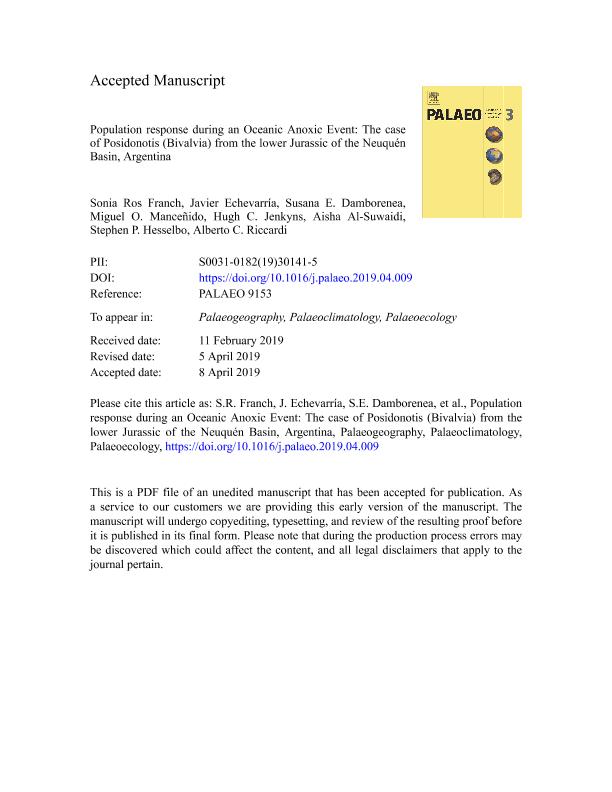Mostrar el registro sencillo del ítem
dc.contributor.author
Ros Franch, Sonia

dc.contributor.author
Echevarría, Javier

dc.contributor.author
Damborenea, Susana Ester

dc.contributor.author
Manceñido, Miguel Oscar

dc.contributor.author
Jenkyns, Hugh C.
dc.contributor.author
Al Suwaidi, Aisha
dc.contributor.author
Hesselbo, Stephen P.
dc.contributor.author
Riccardi, Alberto Carlos

dc.date.available
2021-03-11T20:25:22Z
dc.date.issued
2019-07-01
dc.identifier.citation
Ros Franch, Sonia; Echevarría, Javier; Damborenea, Susana Ester; Manceñido, Miguel Oscar; Jenkyns, Hugh C.; et al.; Population response during an Oceanic Anoxic Event: The case of Posidonotis (Bivalvia) from the Lower Jurassic of the Neuquén Basin, Argentina; Elsevier Science; Palaeogeography, Palaeoclimatology, Palaeoecology; 525; 1-7-2019; 57-67
dc.identifier.issn
0031-0182
dc.identifier.uri
http://hdl.handle.net/11336/128130
dc.description.abstract
Benthonic marine species show a wide range of biological reactions to seawater chemical changes through time, from subtle adjustments to extinction. The Early Toarcian Oceanic Anoxic Event (T-OAE) was recently recognized in the Neuquén Basin, Argentina, confirming its global scope. The event was identified chemostratigraphically on the basis of a relative increase in marine organic carbon and a characteristic negative carbon-isotope excursion (δ13Corg) in bulk rock and fossil wood in the upper Pliensbachian–lower Toarcian interval in the Arroyo Lapa section (Neuquén). Simultaneously with collection of lithological samples, a high-resolution biostratigraphical survey was carried out, and the scarce benthonic fauna was collected in order to check the biotic response to changing marine geochemical conditions. We present here an analysis of size and abundance data from the T-OAE interval in the Neuquén Basin for the dominant bivalve species, the paper-clam Posidonotis cancellata (Leanza), and relate these data to geochemical proxies (%TOC and δ13Corg) obtained at the same locality. The abundance of P. cancellata increased when the rest of the benthos diminished, reaching a maximum at the onset level of the T-OAE, and then decreasing. Size-frequency distributions show a noteworthy lack of juvenile shells. Shell size shows a positive correlation with %TOC in the whole section, though over the T-OAE interval proper, it decreases below the level where the maximum %TOC value is attained and increases above it. Posidonotis cancellata shows features of opportunistic species, such as high tolerance to hypoxia, strong dominance in impoverished environments and a strong dependence on primary productivity, but at the same time had a reproductive strategy more similar to equilibrium species, with relatively low juvenile mortality rates. Several anatomical features suggest adaptation to permanently dysaerobic environments. The species disappeared just before the minimum negative carbon-isotope value was reached; and by the same time the genus became extinct worldwide.
dc.format
application/pdf
dc.language.iso
eng
dc.publisher
Elsevier Science

dc.rights
info:eu-repo/semantics/openAccess
dc.rights.uri
https://creativecommons.org/licenses/by-nc-sa/2.5/ar/
dc.subject
BIOTIC REACTIONS
dc.subject
OPPORTUNISTIC SPECIES
dc.subject
PAPER-CLAMS
dc.subject
SOUTH AMERICA
dc.subject
TOARCIAN OAE
dc.subject.classification
Paleontología

dc.subject.classification
Ciencias de la Tierra y relacionadas con el Medio Ambiente

dc.subject.classification
CIENCIAS NATURALES Y EXACTAS

dc.title
Population response during an Oceanic Anoxic Event: The case of Posidonotis (Bivalvia) from the Lower Jurassic of the Neuquén Basin, Argentina
dc.type
info:eu-repo/semantics/article
dc.type
info:ar-repo/semantics/artículo
dc.type
info:eu-repo/semantics/publishedVersion
dc.date.updated
2021-03-05T18:37:13Z
dc.journal.volume
525
dc.journal.pagination
57-67
dc.journal.pais
Países Bajos

dc.journal.ciudad
Amsterdam
dc.description.fil
Fil: Ros Franch, Sonia. Universidad Nacional de La Plata. Facultad de Ciencias Naturales y Museo. División Paleozoología Invertebrados; Argentina. Consejo Nacional de Investigaciones Científicas y Técnicas. Centro Científico Tecnológico Conicet - La Plata; Argentina
dc.description.fil
Fil: Echevarría, Javier. Universidad Nacional de La Plata. Facultad de Ciencias Naturales y Museo. División Paleozoología Invertebrados; Argentina. Consejo Nacional de Investigaciones Científicas y Técnicas. Centro Científico Tecnológico Conicet - La Plata; Argentina
dc.description.fil
Fil: Damborenea, Susana Ester. Universidad Nacional de La Plata. Facultad de Ciencias Naturales y Museo. División Paleozoología Invertebrados; Argentina. Consejo Nacional de Investigaciones Científicas y Técnicas. Centro Científico Tecnológico Conicet - La Plata; Argentina
dc.description.fil
Fil: Manceñido, Miguel Oscar. Universidad Nacional de La Plata. Facultad de Ciencias Naturales y Museo. División Paleozoología Invertebrados; Argentina. Consejo Nacional de Investigaciones Científicas y Técnicas. Centro Científico Tecnológico Conicet - La Plata; Argentina
dc.description.fil
Fil: Jenkyns, Hugh C.. University of Oxford; Reino Unido
dc.description.fil
Fil: Al Suwaidi, Aisha. Khalifa University Of Science And Technology; Emiratos Arabes Unidos
dc.description.fil
Fil: Hesselbo, Stephen P.. University of Exeter; Reino Unido
dc.description.fil
Fil: Riccardi, Alberto Carlos. Universidad Nacional de La Plata. Facultad de Ciencias Naturales y Museo. División Paleozoología Invertebrados; Argentina. Consejo Nacional de Investigaciones Científicas y Técnicas. Centro Científico Tecnológico Conicet - La Plata; Argentina
dc.journal.title
Palaeogeography, Palaeoclimatology, Palaeoecology

dc.relation.alternativeid
info:eu-repo/semantics/altIdentifier/doi/https://doi.org/10.1016/j.palaeo.2019.04.009
dc.relation.alternativeid
info:eu-repo/semantics/altIdentifier/url/https://www.sciencedirect.com/science/article/pii/S0031018219301415?via%3Dihub
Archivos asociados
